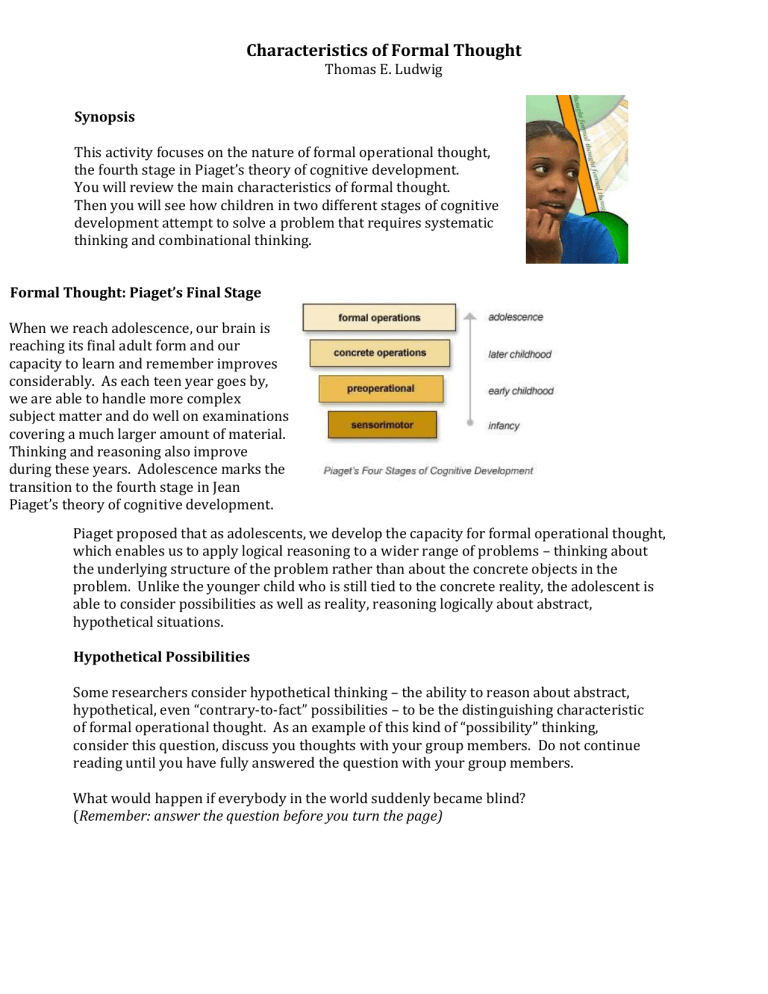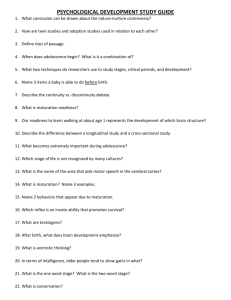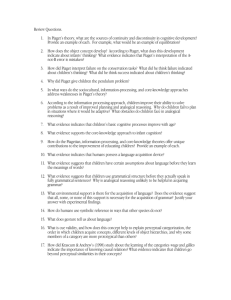Formal Thought: Piaget's Cognitive Development Stages

Characteristics of Formal Thought
Thomas E. Ludwig
Piag
Synopsis
This activity focuses on the nature of formal operational thought, the fourth stage in Piaget’s theory of cognitive development.
You will review the main characteristics of formal thought.
Then you will see how children in two different stages of cognitive development attempt to solve a problem that requires systematic thinking and combinational thinking.
Formal Thought: Piaget’s Final Stage
When we reach adolescence, our brain is reaching its final adult form and our capacity to learn and remember improves considerably. As each teen year goes by, we are able to handle more complex subject matter and do well on examinations covering a much larger amount of material.
Thinking and reasoning also improve during these years. Adolescence marks the transition to the fourth stage in Jean
Piaget’s theory of cognitive development.
Piaget proposed that as adolescents, we develop the capacity for formal operational thought, which enables us to apply logical reasoning to a wider range of problems – thinking about the underlying structure of the problem rather than about the concrete objects in the problem. Unlike the younger child who is still tied to the concrete reality, the adolescent is able to consider possibilities as well as reality, reasoning logically about abstract, hypothetical situations.
Hypothetical Possibilities
Some researchers consider hypothetical thinking – the ability to reason about abstract, hypothetical, even “contrary-to-fact” possibilities – to be the distinguishing characteristic of formal operational thought. As an example of this kind of “possibility” thinking, consider this question, discuss you thoughts with your group members. Do not continue reading until you have fully answered the question with your group members.
What would happen if everybody in the world suddenly became blind?
(Remember: answer the question before you turn the page)
Answering the Hypothetical Question
Researchers have used this question to distinguish concrete operational thought from formal thought. Concrete-stage thinkers are likely to get caught up in the fact that everyone is not blind. If they are able to come up with any answers to this question, it tends to be simplistic, as in “If everybody became blind, no one would be able to see.” In contrast, formal-stage thinkers can accept the “contrary-to-fact” nature of the question, move beyond the abstraction, and reason about the implications of this situation. They would be likely to produce more complex and creative answers, such as “If everybody became blind, those who had already been blind would be the new leaders.”
Systematic Reasoning
Another aspect of formal thought is systematic thinking – the ability to reason carefully through a sequence of steps, without skipping a step. Piaget tested this characteristic with a task known as the pendulum problem. He gave children the assignment of discovering what determines the rate at which a pendulum oscillates (swings back and forth).
He showed children how to manipulate four possible factors:
1. length of the string (given a short string and a long string)
2. amount of weight (given a heavy weight and a light weight)
3. point of release (high or low)
4. force of release (drop the weight, or push it)
Their task was to identify which factor or factors, alone or in combination, determined the rate of oscillation. How would you approach this problem? Discuss your ideas with your group members before reading the answer. Try to put your steps in the space below.
Solving the Pendulum Problem
Researchers find that the pendulum problem separates the concrete operational children from the formal operational teens. Which style of thinking best fits the strategy you described for the pendulum problem?
Concrete-stage thinkers approach the task haphazardly, manipulating the variables almost at random, and rarely arrive at the correct solution. For example, an 8-year-old might first try the heavy weight with a long string, and then the light weight with a short string, and mistakenly conclude that the weight determines the oscillation rate.
In contrast, formal-stage thinkers approach the task systematically, varying one factor at a time while holding all other factors constant. A 15-year-old might first try a heavy weight with the long string, and then the light weight on the same string, being careful to release the weight at the same height and with the same force both times.
She might then repeat the same process with the short string, and then move systematically through the other variables until she reached the correct conclusion that only one factor influences the oscillation rate: the length of the string.
Combination Logic: The Sandwich Game
A third aspect of formal thought is closely related to the first two. It’s called combinational logic – the ability to generate all possible combinations of variables in order to solve a problem.
Researchers often use a task called the sandwich problem to test combinational logic.
The researcher gives the children bread and a set of four sandwich ingredients (meat, cheese, honey, and peanut butter) and asks them how many different kinds of sandwiches they could make with those ingredients.
Ingredients:
Bread Ham Cheese Honey Peanut Butter
+
How many different kinds of sandwiches can you make? Compare your answers with your group members.
Sandwich Combinations: Concrete Operational Stage
Most elementary-school children in the concrete operational stage have trouble with this task. They generate some of the possible sandwiches (usually around 4-5 different sandwiches), but they overlook other combinations – and sometimes repeat the same combination two or three times.
Sandwich Combinations: Formal Operational Stage in Adolescence
In contrast to younger children, teens in the formal operational stage find it easy to generate all the possible combinations. They often follow a strategy of laying out the sandwiches in rows and columns to make sure they don’t overlook any of the combinations (usually coming up with 15 different sandwiches).
Implications of Formal Thought
Formal thought may be helpful for planning sandwich menus, but it is crucial for the demanding science and mathematics classes in high school. In particular, the ability to generate all possible combinations of variables, and then step systematically through those combinations to test them, underlies much of scientific research.
The same formal thought processes that enable adolescents to tackle complicated science problems also help them function as more flexible, resourceful thinkers outside the classroom. This new reasoning power is evident in adolescents’ pondering and debating such abstract topics as human nature, good and evil, truth and justice. They also lay the foundation for the struggle to define one’s identity – a person’s definition or description of himself or herself, including the values, beliefs, and ideals that guide the individual’s behavior.
Limitations of Formal Thought
Although Piaget’s theory of cognitive development continues to be influential, contemporary developmental psychologists point out the following limitations to this theory:
Piaget underestimates the importance of culture and education in promoting intellectual development. Studies testing adolescents and adults from nonindustrial societies suggest that in those cultures only a small minority of teens and adults can pass Piaget’s tests of formal operations – so some minimum education in math and science may be a prerequisite for formal-stage thinking.
Piaget overestimated the number of people who attain formal operational thought. Recent research shows that the growth of formal reasoning ability is far slower and less complete than Piaget believed it to be – these cognitive gains are not always accomplished during adolescence, nor are they necessarily acquired by all people.
Formal operational thinking is not comprehensive – that is, it’s more likely to be determined in some domains and not in others. For example, nurses are more likely to demonstrate formal-stage thinking on problems related to medical emergencies, while they fall back on concrete-stage thinking when reasoning about why their car won’t start.
The new cognitive abilities of adolescence can produce an enhanced capacity for self-centeredness called adolescent egocentrism – the belief that their own psychological experiences are unique. Apparently many teens are convinced (for a while, at least) that no one has ever loved as deeply, or been hurt as badly, as they have.
Adolescent egocentrism also makes some teens believe that they are immune to common dangers that apply to ordinary mortals, leading them to engage in risky behaviors such as drinking and driving, or unprotected sex.
In spite of these concerns, most researchers believe that the capacity for formal operations represents a genuine change in the quality of adolescent thinking – a change that will prepare teens for successful adaptation to the world of adulthood.
Check Your Understanding
1. A distinguishing feature of adolescent thought is the capacity to think in terms of possibility rather than only in terms of reality.
☐
True
☐
False
2. Concrete-stage thinkers approach a problem haphazardly, while formal-stage thinkers can reason systematically, step by step, to arrive at a solution.
☐
True
☐
False
3. Many elementary school children are egocentric enough to believe that their experiences are unique, but by the time teens have developed formal thought, their egocentrism has disappeared.
☐
True
☐
False
4. The development of combinatorial logic explains why teens perform better on the sandwich problem than elementary school children do.
☐
True
☐
False
5. Piaget believed that all children of normal intelligence would acquire formal operations in early adolescence. Other researchers have questioned this assumption. In the space below, try to explain in your own words why formal thought may not be a universal experience for young teens.


